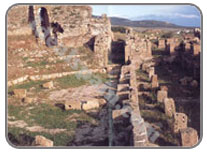|
While
Tarragona
has its own
municipal
beaches, the
nearest resort
of
international
fame is
Salou
about 10km
down the coast
with its long,
palm-lined
promenade that
has recently
undergone
extensive
remodelling.
The nightlife
here is
friendly and
informal and
there are
ample shops
and
facilities.
The resort is
well
established
and is popular
with the
British. Water
sports are
available here
and a day out
at the theme
park, Port
Aventura is a
must with its
five themed
lands.
|
|
|
|
Modern
apartment
blocks have
maintained a
clean standard
and the
gardens are
all well kept
in the centre.
The beaches of
Salou are
certainly the
resort's main
attraction.
The sand is
fine and
golden; the
beaches are in
first class
condition and
the Salou
coastline is
varied. Wide
expanses of
golden sand
blend in with
beachfront
hotels and
residences,
while other,
more intimate
beaches are
sheltered by
pine trees and
beautiful
inlets and
coves.
|
| |
|
|
| Low cost car hire in this part of Spain - Instant quotes, online booking and guaranteed reservations. Access to all the top car hire companies in Spain |
| |
|
|
|
Poniente beach
is more than a
kilometre
long. This
beach joins up
with that of
the
neighbouring
resort of
Cambrils. In
the times when
mixed bathing
was not
allowed, this
was the
"Ladies'
Beach".
Llevant
beach
is the longest
in the resort
at 1,200
metres, and
the most
popular.
During the
summer, an
area is set
aside for
various
sporting
activities. In
the old days
it was the
"Men's Beach"
and it is
separated from
the Poniente
Beach by the
port.
Capellans
beach
is an
attractive
beach, 220
metres long
and can be
reached from
Bruselles
Street.
Llenguadets
beach
is a small
cove that can
only be
reached on
foot from
Tortosa
Street.
Llarga
beach
is a 600 metre
long beach
bordered by
pine trees.
Best reached
from
Replanells
Street, off
the Salou -
Tarragona
coast road.
Penya-Tallada
beach is a
small,
unspoilt cove
of great
natural
beauty, 125
metres long.
Cala de la
Font beach
gets its name
from a
freshwater
spring that
flowed
permanently up
until a few
years ago. It
is 70 metres
long and can
be reached
from Les Dunes
Street.
Cala
Crancs beach
is the
easternmost of
Salou's
beaches and
one of the
most
attractive. It
is 50 metres
long and can
be reached by
taking the
Faro de Salou
road and Pins
de Cintet
Street in the
Urbanización
Núria.
|
|
| |
|
The history
of Salou
Salauris, as
the Romans
originally
called it, has
an immense
amount of
history. After
the Romans and
the Saracens,
Salou was
considered
part of the
Tarragona
religious
heritage. King
James I was
the first to
sing the
praises of its
excellent port
and decided to
bring his
entire fleet
here. He
disembarked
from the Port
of Salou to
conquer
Majorca on 6
September
1229. The
inhabitants of
Salou have
always
remembered
this event and
that's why the
main promenade
is named after
him. Pirates
soon
discovered
this port as
well and they
turned it into
one of the
principal
sites of their
looting. As a
result, the
area became
less inhabited
and in 1530
the Archbishop
of Tarragona,
Pere Cardona
ordered that a
defence tower,
now called
Torre Vella or
Old tower be
built. In 1766
the Santa
Maria del Mar
Church was
consecrated
and shortly
after the road
from Reus to
Salou was
build. In 1858
the lighthouse
on Cape Salou
was opened.
Beach huts
were
authorized
1863 and in
1865 the train
station began
operating. The
well known
Reus-Salou
Carrilet local
train was
started in
1887 and
brought the first summer
tourists to
the town. From
the early 20th
century to the
1960's Salou
grew sharply
as a result of
tourism,
making Salou
what it is
today; a
beautiful
summer town. |
|
|
|
The
weather in
Salou
The
vegetation
of Salou
is
typically
Mediterranean.
The
climate is
characterized
by mild
temperatures
throughout
the year.
The area
around
Salou is
well
preserved
and has
many
native
species of
plants.
There are
also many
gardens
and parks
with local
and
imported
vegetation.
One such
area is
the Jaume
I
Promenade
where the
variety of
flowers
and
colours
and the
impressive
palm trees
have made
it into
the emblem
of the
resort.
Salou's
suburb of
Vilafortuny,
with
another
long beach
consists
mainly of
exclusive
villas
surrounded
by high
fences.
Nearby
Cambrils
has a
distinct
Spanish
flavour
and has a
working
fishing
port. It
has a soft
beach of
9km with
water
sports in
the
summer.
Cambrils
is also
known as a
gourmet
town. its
waterfront
plays home
to more
seafood
restaurants
than most
major
cities.
Enthusiasts
drive here
from miles
around to
sample the
cuisine.
|
|
| |
|
|





